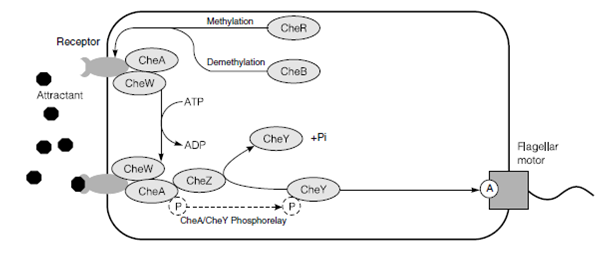Chemotaxis
Microorganisms, through definition exist on a microscopic scale and this means that in relative terms, separation from a food source by only a few millimeters presents an enormous challenge. Most bacteria have some form of motility using pili or gliding or merely by extending colony size. To conserve energy movement must not be random, depending on a chance encounter with a food source but directed. The sensing process provides this direction.
If movement is towards an organic compound this is named chemotaxis but other forms of taxis exist. These include geotaxis movement towards or away from gravity and phototaxis movement towards or away from light. The best understood chemotactic system is formed by the Che proteins present in several Gram-negative Bacteria.
In response to the presence of a suitable carbon source a transducer is also known as MCP forms a complex with a sensor kinase CheA. The transducer functions as a medium to pass a signal from the periplasm and across the cytoplasmic membrane. Unlike the simpler two-component sensors the transducer and sensor kinase interaction is mediated through a coupling protein, CheW. However the result is still the phosphorylation of CheA.
The signal is carried through the cytoplasm through transfer of the phosphate group to CheY. Phosphorylated CheY-P has a direct interaction with the flagellar motor switch changing the direction of rotation. Once CheY-P has acted on the motor, it is dephosphorylated through CheZ in Figure and rotation continues in the original anticlockwise direction.As the microbe approaches the food source and the concentration of the inducer changes the cell must adapt its chemotactic response so as not to overshoot. This adaptation is provided through the second phosphorelay protein CheB.

Figure: Chemotaxis is controlled by the Che proteins.
A methylation protein, CheR is constantly methylating the transducer but CheB can demethylate the transducer. The number of methyl groups attached to the transducers in the cell membrane influences the efficiency of sensor kinase phosphorylation. The competition to methylate ChyR or demethylate CheB the transducer adapts the cell’s response to a stimulant.